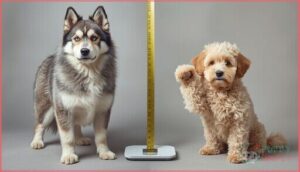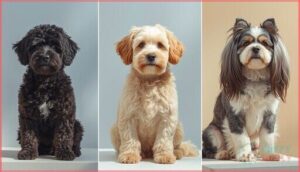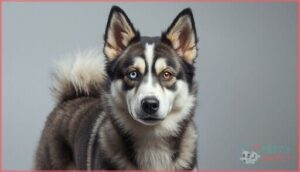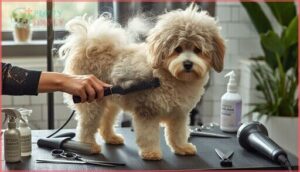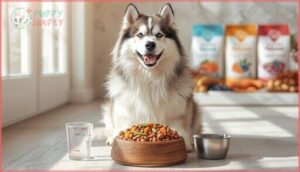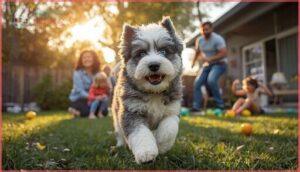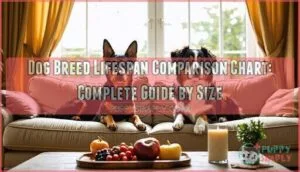This site is supported by our readers. We may earn a commission, at no cost to you, if you purchase through links.
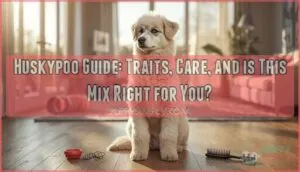
The result? A dog that thrives on attention, exercise, and mental challenges. Huskypoos aren’t for everyone, though. Their high energy levels and stubborn streak mean they need owners who can provide structure, activity, and consistent training.
Understanding what makes this hybrid tick will help you decide if a Huskypoo fits your lifestyle.
Table Of Contents
- Key Takeaways
- What is a Huskypoo?
- Huskypoo Physical Characteristics
- Huskypoo Temperament and Personality
- Huskypoo Socialization and Behavior
- Exercise Needs for Huskypoos
- Grooming Requirements for Huskypoos
- Common Health Issues in Huskypoos
- Feeding and Nutrition for Huskypoos
- Training Huskypoo Puppies
- Is a Huskypoo Right for Your Family?
- Frequently Asked Questions (FAQs)
- What is the best way to socialize a Huskydoodle puppy?
- How does the Huskydoodle interact with other pets, especially smaller animals?
- What specific activities or games do Huskydoodles particularly enjoy?
- Are there any specific dietary needs or restrictions for Huskydoodles?
- How does the Huskydoodle’s behavior and needs change as it ages?
- How much does a Huskypoo puppy cost?
- Can Huskypoos tolerate hot or cold weather?
- Do Huskypoos bark or howl frequently?
- What are the best toys for Huskypoos?
- How do I find a reputable Huskypoo breeder?
- Conclusion
Key Takeaways
- Huskypoos need 60 to 120 minutes of vigorous daily exercise and thrive with active, experienced owners who can provide consistent training to manage their high energy and stubborn streak inherited from the Husky parent.
- This designer mix isn’t truly hypoallergenic despite marketing claims, but about 55% inherit curly, low-shedding coats from their Poodle parent that require daily brushing and professional grooming every 6 to 8 weeks to prevent matting.
- Early socialization between 3 and 14 weeks is critical since Huskypoos can develop separation anxiety in up to 50% of cases and may show prey drive toward smaller pets without proper training and supervision.
- These dogs inherit genetic health risks from both parents including hip dysplasia, eye disorders like cataracts and progressive retinal atrophy, and typically live 12 to 15 years with proper veterinary care and weight management.
What is a Huskypoo?
A Huskypoo is a mixed breed dog that comes from crossing a Siberian Husky with a Poodle. This designer dog combines traits from both parent breeds, creating a unique companion with distinct characteristics.
Let’s look at where this mix comes from, how it’s recognized, and why people choose this breed.
Siberian Husky and Poodle Origins
When you’re bringing home a Huskypoo, you’re blending two legendary working breeds. The Siberian Husky traces back over 4,000 years to the Chukchi people, bred for husky sledding across the tundra. Meanwhile, Poodles started as hunting dogs in 15th-century Germany before French breeders refined them for retrieving waterfowl.
These parent dogs bring serious genetic history, combining endurance with intelligence in your mixed-breed companion. The Huskies’ ancestors were essential for the Chukchi people’s survival.
Recognition by Breed Clubs
The American Kennel Club doesn’t recognize Huskypoos as an official breed, and you won’t find them eligible for AKC purebred status. However, this designer dog has found a home with hybrid registries like the American Canine Hybrid Club and International Designer Canine Registry.
These organizations track doodle breed lineages and offer registration services, though breed standards remain less defined than traditional purebreds. The AKC Canine Partners program is an option for mixed breeds.
Reasons for Popularity
You might wonder why Huskypoos have become so popular. Nearly half of designer breed owners—47%—pick them for allergy-friendly coats that shed less than pure Huskies.
Family compatibility ranks high too, with 56% drawn to their kid-friendly temperament. Training ease and adaptable activity levels make them flexible family pets.
Between 2019 and 2020, designer demand jumped over 7%, fueling Huskypoo popularity even more.
Huskypoo Physical Characteristics
Huskypoos can look quite different from one dog to the next, depending on which parent they take after. You’ll find a wide range of sizes, coat textures, and colors in this mixed breed.
Here’s what you can expect regarding their physical traits.
Size and Weight Range
Huskypoos come in two main size categories that depend on whether you’re looking at a standard or mini version.
Standard Huskypoos generally stand 20 to 25 inches tall and weigh between 35 and 60 pounds as adults.
Mini Huskypoos are smaller, ranging from 12 to 20 inches in adult height and weighing 15 to 35 pounds when fully grown.
Coat Types and Colors
Your Huskypoo’s coat genetics determine whether you’ll meet a curly, wavy, or straight-haired companion. About 55% inherit curly dog coats from their Poodle parent, offering stronger hypoallergenic potential and lower shedding levels.
Coat type directly impacts grooming needs and color rarity varies widely.
- Black, white, and gray dominate, appearing in 70% of dogs
- Multi-color patterns like black-and-white show up in 40%
- Red, apricot, and cream are rarer, found in 18%
- Marbled coats appear in just 10%
Distinctive Features
What sets your Huskypoo apart visually? Heterochromia prevalence reaches 35%, giving some dogs one blue and one brown eye—a stunning trait from their Husky Poodle appearance.
About 85% display facial masking around the eyes, while ear carriage splits between floppy ears (67%) and erect triangles. Tail curvature appears in 72%, often curled over the back.
Their muscular build and coat type create unmistakable Huskypoo breed characteristics.
Huskypoo Temperament and Personality
Your Huskypoo’s personality is where the magic really happens. These dogs bring together the best traits from both parent breeds, creating a companion that’s equal parts clever and cuddly.
Let’s look at what makes their temperament so special and what you can expect day to day.
Loyalty and Affection
You’ll find your Huskypoo shadowing you from room to room, waiting by the door, and claiming a spot right next to you on the couch. About 89% of owners report frequent cuddling behavior, and these dogs form tight bonds with every family member. They’re the definition of a velcro dog temperament.
Huskypoos are velcro dogs—89% shadow their owners everywhere, cuddling constantly and bonding with every family member
Bonding Behaviors and Affection Displays You’ll Notice:
- Room-to-room following – Roughly 77% of Huskypoos trail their owners throughout the house, showing constant attachment.
- Enthusiastic greetings – Expect tail wagging and excited vocalizations when you come home (91% of owners report this).
- Affectionate licking – About 78% of Huskypoos “kiss” faces and hands as their go-to affection indicator.
- Sleeping nearby – 84% choose to sleep close to their humans, signaling deep comfort and trust.
- Playful attention-seeking – 87% bring toys or gently paw at you to initiate positive interactions.
This family dog thrives on being part of your daily routine. In homes with multiple people, 81% seek affection from everyone, not just one person. That Poodle ancestry brings strong attachment tendencies, while the Siberian Husky side adds a need for constant companionship. Together, these traits create a family pet that genuinely wants to be involved in everything you do.
Your Huskypoo will comfort you during tough moments too. Around 68% initiate soothing behaviors like leaning in or sitting close when they sense distress. They’ll also alert you to unusual sounds (61% do this) as a protective gesture. Keep in mind that this intense bonding can lead to separation anxiety in up to 50% of dogs if left alone too long. Including your Huskypoo in family activities reduces destructive behaviors by 62%, so make them part of your household rhythm.
This breed comparison shows they often bond more strongly in multi-person homes than purebred Huskies, making them ideal for families seeking a devoted, affectionate companion with balanced dog behavior.
Intelligence and Trainability
Training this crossbreed feels like partnering with a quick learner who occasionally questions your authority. Your Huskypoo inherits second-place dog intelligence from its Poodle parent, mastering new commands in about 3.4 repetitions. That’s roughly 31% faster than purebred Huskies. Problem-solving comes naturally—53% nail at least 10 of 12 cognitive challenges. Skill retention stays strong at 80% accuracy a month post-training.
| Training Aspect | Huskypoo Performance |
|---|---|
| Learning speed | 3.4 repetitions per command |
| Obedience success | 95%+ with consistent training |
| Problem-solving | 53% excel in cognitive tests |
| Skill retention | 80% accuracy after 30 days |
| Adaptability | 18% above average with socialization |
Positive reinforcement works best—daily 15-minute sessions boost compliance considerably. Expect stubbornness from that Husky side, though. About 25% test boundaries during housebreaking, so start Huskypoo dog training at eight weeks. Early intervention cuts behavioral issues by 40%. Experienced owners report the smoothest outcomes, especially when balancing firmness with patience during dog training sessions.
Energy Levels and Playfulness
You’ll notice your Huskypoo’s energy level matches marathon runners more than couch potatoes. Expect 60-90 minutes of vigorous exercise daily—running, hiking, or dog sports work best.
This activity level demands diet adaptation with higher protein portions and careful calorie management.
Playful bonding continues into adulthood, strengthening your connection while meeting their lifestyle needs.
Regular exercise prevents destructive behavior from unused energy, making consistent routines essential.
Huskypoo Socialization and Behavior
Huskypoos can be wonderful family companions, but their success depends heavily on early socialization.
How they interact with kids, other pets, and small animals varies based on training and exposure. Let’s look at what you need to know about their social behavior and how to set them up for success.
Interaction With Children
Huskypoos can make wonderful family pets when you understand their temperament and animal behavior needs. Supervision importance can’t be overstated—never leave young children alone with your Huskypoo, as their high energy can lead to accidental knocks or overly excited play.
Safe interactions start with gradual introductions and teaching kids gentle handling. Watch for behavioral patterns like stress signals (yawning, lip licking) and create designated safe zones for both.
Compatibility With Other Pets
Just like with kids, getting along with other pets depends on your Huskypoo’s temperament and behavior. Socialization importance can’t be stressed enough—start early for safe cohabitation. While poodles generally show better breed tolerance toward smaller animals, the husky side brings prey drive into the mix.
Here’s what impacts success with family pets:
- Early exposure to various animals reduces dog aggression risks
- Supervision strategies prevent predatory incidents with small pets
- Gradual introductions help assess individual temperament
- Escape routes for smaller animals reduce stress
- Positive reinforcement during calm interactions builds trust
Most Huskypoos do well with other dogs when properly introduced.
Managing Prey Drive
That prey drive isn’t just training—it’s genetic factors passed down from both parent breeds. Your Huskypoo needs early intervention during those first 14 weeks to shape behavior.
Use safety protocols like long leads and fenced areas while teaching impulse control. Mental stimulation through puzzle toys satisfies hunting instincts without chasing.
Redirect with training techniques like predation substitute games, and you’ll see less reactive behavior around small animals.
Exercise Needs for Huskypoos
Your Huskypoo isn’t a couch potato, and you’ll figure that out fast. These energetic dogs need a solid workout routine to stay happy and healthy.
Let’s break down what that looks like in real life so you can plan your days accordingly.
Daily Activity Requirements
Your Huskipoo exercise needs 60 to 120 minutes of regular exercise daily to stay healthy and happy. Puppies under six months need just 20 to 40 minutes to protect growing joints. Seniors usually do well with 30 to 60 minutes of gentler activity.
Age adjustments matter—insufficient exercise leads to destructive chewing and weight gain. Monitor your dog’s energy level and adapt to seasonal impact, especially during hot weather.
Suitable Activities and Sports
Agility training, hiking companions, and fetch games satisfy your Huskypoo exercise needs perfectly. These dogs excel at dog sports that challenge both body and mind.
Water sports can provide low-impact, full-body workouts—Poodles naturally love swimming, while Huskies may enjoy shallow water play. Some even have sledding potential in colder climates.
Vary activities to match your dog’s energy level and keep regular exercise engaging.
Preventing Boredom and Destruction
Channeling all that energy keeps your Huskypoo happy and your furniture intact. Without structured playtime and regular exercise to match their energy levels, boredom leads to chewing, digging, and household chaos—studies show destructive behaviors drop considerably with proper dog exercise and training routines.
Essential prevention strategies include:
- Puzzle feeders during mealtimes for mental stimulation
- Toy rotation every few days to maintain novelty
- Crate training for safe, supervised alone time
- Social interaction with family members throughout the day
- Structured playtime scheduled into your daily routine
Meeting Huskypoo exercise needs prevents most behavioral problems before they start.
Grooming Requirements for Huskypoos
Huskypoos need consistent grooming to keep their coats healthy and tangle-free. The amount of work depends on whether your dog inherits the Poodle’s curls or the Husky’s thicker fur.
Here’s what you’ll need to stay on top of to keep your Huskypoo looking and feeling their best.
Brushing and Coat Maintenance
Your Huskypoo’s coat care depends on what type they inherited. Curly coats need daily brushing to prevent mats, while straighter double coats can go with twice-weekly sessions.
Pay extra attention behind the ears and armpits, where tangles love to hide.
During shedding seasons in spring and fall, you’ll want to brush daily using a slicker brush or undercoat rake to manage that extra fur.
Bathing, Trimming, and Nail Care
Beyond brushing, your Huskypoo needs bathing every 4 to 6 weeks with dog-safe shampoo. Professional trimming every 6 to 8 weeks prevents matting, with popular styles like the teddy bear cut keeping things manageable.
Don’t forget nail trimming every 3 to 4 weeks—if you hear clicking on hard floors, it’s time. Home grooming saves money but requires proper tools and technique.
Managing Shedding and Allergies
Despite the “hypoallergenic” label, no dog is truly non-shedding or allergen-free. Huskypoos vary in shedding frequency depending on which parent they favor.
Daily brushing during spring and fall reduces loose fur by over 50%. Grooming interventions like weekly baths reduce allergen production considerably.
Environmental management—HEPA filters, pet-free zones—and dietary factors like omega-3s further minimize dog allergies and dog shedding issues.
Common Health Issues in Huskypoos
Like any mixed breed, Huskypoos can inherit health problems from either parent. Some conditions show up more often in these dogs than others.
Here’s what you need to watch for to keep your Huskypoo healthy.
Genetic Health Risks
Your Huskypoo can inherit health concerns from both parent breeds. Hip dysplasia ranks lower in Huskies—only 2.2% affected—but Poodles carry higher risk.
Eye disorders like cataracts affect 8% of screened Huskies, while progressive retinal atrophy appears early in some lines.
Neurologic risks include degenerative myelopathy and epilepsy. Autoimmune issues like allergies and hypothyroidism also run in these families, so understanding inheritance patterns helps you prepare.
Preventive Veterinary Care
Your dog’s best defense against health issues starts with yearly wellness exams. Schedule one to two veterinary visits annually to catch problems early—these checkups uncover undiagnosed conditions in 14% of adults and 40% of seniors.
Keep vaccination schedules current, especially for distemper, parvovirus, and rabies. Parasite control works best year-round, and don’t skip dental hygiene—76% of dogs develop dental disease without preventative screening and care.
Lifespan Expectations
With proper care, your Huskipoo’s life span usually ranges from 12 to 15 years. Hybrid vigor from this cross can benefit breed longevity, though genetic predispositions from both parent breeds still matter.
Comparative lifespans show Huskies and Poodles living similar ranges. Lifestyle impact—especially exercise and weight management—plays a huge role in dog lifespan. Keep your dog lean and active to extend those healthy years together.
Feeding and Nutrition for Huskypoos
Your Huskypoo’s diet plays a huge role in their health, energy, and overall well-being. These active dogs need the right balance of nutrients to fuel their playful lifestyle and maintain that gorgeous coat.
Let’s look at what to feed them, how much, and what foods you should keep off their plate.
Recommended Diet and Portions
Your Huskypoo needs a diet that fuels their energetic lifestyle. Aim for dog food with about 30% protein and 50% fat to support muscle and energy. A 40-pound dog generally needs 1,300–1,800 calories daily, depending on activity level. Watch for dietary sensitivities common in Poodles and Huskies, and ensure proper hydration—about 30 ml of water per pound daily.
- Protein-packed meals keep those zoomies going strong
- Healthy fats fuel adventures without the crash
- Allergy-friendly options mean fewer vet visits and happier bellies
- Proper portions prevent the dreaded “chonk” phase
- Fresh water access keeps tails wagging all day long
Feeding Schedule and Tips
Knowing the right portions is just half the battle—timing matters too. Feed puppies under 12 weeks four times daily, dropping to three meals by six months, then twice daily for adults.
Space meals 10–12 hours apart to aid digestion and prevent bloat. Remove uneaten dog food after 20 minutes, and skip exercise for an hour post-feeding—smart dog care that aids your pup’s health.
Foods to Avoid
Just as timing your pup’s meals protects against bloat, knowing which foods to avoid safeguards dog health. Toxic foods like chocolate, grapes, onions, and xylitol cause severe dog health issues—even death.
Watch for problematic additives (BHA, BHT) and common allergens (beef, dairy, wheat) in dog food. Skip cooked bones, yeast dough, and processed risks that threaten your Huskypoo’s well-being through careful dog care.
Training Huskypoo Puppies
Training your Huskypoo puppy takes patience and consistency, but it’s worth the effort. These smart dogs can pick up commands quickly, though their independent streak sometimes makes them test your limits.
Here’s what you need to focus on to raise a well-behaved companion.
Housebreaking and Obedience
You’ll find that housebreaking your Huskypoo puppy takes about four to eight weeks with consistent daily routines. Crate training improves success rates substantially, and positive reinforcement works far better than punishment-based methods.
Here’s your game plan:
- Take your puppy outside hourly, especially 15-20 minutes after meals or play
- Use high-value treats to reward outdoor elimination immediately
- Practice the “stop and go” leash technique to improve manners
- Schedule feeding times to predict bathroom needs
- Address stubbornness with patience—it may extend training by 2-4 weeks
Consistency prevents regression in previously trained dogs.
Socialization Strategies
Why does the socialization window matter so much? Your Huskypoo’s brain is most receptive between 3 and 14 weeks. Early exposure to diverse people, pets, and environments during this period reduces fear and aggression later.
Structured interactions with well-socialized dogs teach proper communication. Gradual introduction to sounds and places builds confidence.
Progress monitoring with treats and praise reinforces success, while preventing overexposure protects against lasting anxiety.
Addressing Stubbornness
Why does your Huskypoo ignore commands? Training compliance improves over 50% when you swap punishment for motivator rewards like treats. Use consistent cues and short sessions to beat boredom.
Early intervention before 12 months cuts stubborn Huskypoo temperament and behavior by 41%. Mental stimulation through games keeps your pup’s brain engaged.
Firm, patient dog training works best—stubbornness fades with the right approach.
Is a Huskypoo Right for Your Family?
Bringing a Huskypoo into your home is a big decision that affects your whole family. These dogs need the right environment, a committed owner, and a lifestyle that matches their energy and needs.
Let’s look at the key factors that will help you decide if a Huskypoo is the right fit for you.
Ideal Living Environment
You need a house with a secure, fenced yard—apartments won’t cut it for this energetic mix. Space Requirements dictate at least 60 to 120 minutes of vigorous exercise daily, and your Huskypoo can jump fences up to six feet.
Climate Adaptation is manageable in both cold and moderate warmth, but your Yard Size and Fencing Needs matter most for preventing escapes and destructive boredom.
Owner Commitment and Experience
Owning a Huskypoo isn’t for beginners—you’ll invest at least 60 minutes daily in exercise and ongoing training challenges that test your patience. First-time owners face 30% more behavioral issues, while experienced handlers report far fewer struggles with stubbornness.
Your lifestyle adjustments will be real: 42% of owners reorganize schedules around dog care, and unmet owner expectations often lead to separation anxiety and destructiveness in these intelligent, demanding dogs.
Assessing Family Lifestyle and Needs
Your household setup matters more than you think. Before committing to this dog ownership journey, run through these Huskipoo adaptability and living conditions essentials:
- Household Space: 92% of owners need secure backyards—apartment living rarely works
- Energy Levels: Match your family dynamics to 60+ minutes of daily activity
- Compatibility Tests: 88% success rate among experienced, active families
- Size Variations: Plan for 8-25 inches, 6-60 pounds
- Lifestyle Assessment: Flexible schedules prevent rehoming risks
Frequently Asked Questions (FAQs)
What is the best way to socialize a Huskydoodle puppy?
Think early socialization’s just playing puppy dates? You’re overlooking the 3-to-12-week window.
Daily positive reinforcement, varied environmental exposure, and controlled canine communication build confident Huskydoodle puppies—reducing adult fear responses by thirty-five percent.
How does the Huskydoodle interact with other pets, especially smaller animals?
Your Huskydoodle will likely get along great with other dogs—about 73% are friendly when socialized early.
However, their prey drive means you’ll need to carefully supervise interactions with smaller animals like cats, rabbits, or hamsters.
What specific activities or games do Huskydoodles particularly enjoy?
Your energetic companion thrives on fetch games, puzzle toys, and outdoor hiking. Huskypoos excel at agility training and interactive play, requiring consistent exercise.
Puppy training and socialization through dog training tips promote well-rounded development.
Are there any specific dietary needs or restrictions for Huskydoodles?
Your dog thrives on 25–30% protein and 15–20% fat, avoiding grapes, chocolate, xylitol, and onions.
Feed two daily portions to prevent bloat, and consider supplements for joints and coat health based on activity levels.
How does the Huskydoodle’s behavior and needs change as it ages?
Like people, your companion transforms over time. Puppy development demands intensive socialization and training; the adolescent phase tests patience.
Adult stability brings predictability, while senior care requires gentler exercise and monitoring for age-related changes.
How much does a Huskypoo puppy cost?
Expect to pay between $800 and $1,300 from reputable breeders for Huskipoo puppies, though premium pedigrees can reach $2, Adoption costs run $400–$600, often including initial veterinary care and health guarantees.
Can Huskypoos tolerate hot or cold weather?
Your Huskypoo can handle Arctic blasts like a champion—down to -50°F—but summer heat above 86°F? That’s when cold-weather genes meet serious heat stress, requiring shade, water, and careful climate management.
Do Huskypoos bark or howl frequently?
Yes, they can be vocal. Most bark less than many breeds, but 42–57% howl due to their Husky genes. Training cuts barking by 44%, and proper exercise reduces unwanted canine communication markedly.
What are the best toys for Huskypoos?
Your Huskipoo needs sturdy chew toys like Kong-brand rubber options, interactive puzzles to challenge that clever brain, durable fetch balls, and sensory mats. These keep your dog entertained and mentally sharp.
How do I find a reputable Huskypoo breeder?
Start by checking breeder credentials through AKC Marketplace or Good Dog. Request health guarantees and genetic testing records.
Visit facilities in person, meet parent dogs, and avoid puppy mills by verifying USDA inspection status.
Conclusion
Picture a dog that can race through snowdrifts one moment and curl up quietly beside you the next. That’s the Huskypoo—a mix of boundless energy and gentle loyalty. If your days are full of activity, challenge, and patience, this breed can become a true partner.
But if you prefer calm routines, a Huskypoo may feel like a square peg in a round hole. Choose with care; the right match sets both you and your dog up for a rewarding journey.

